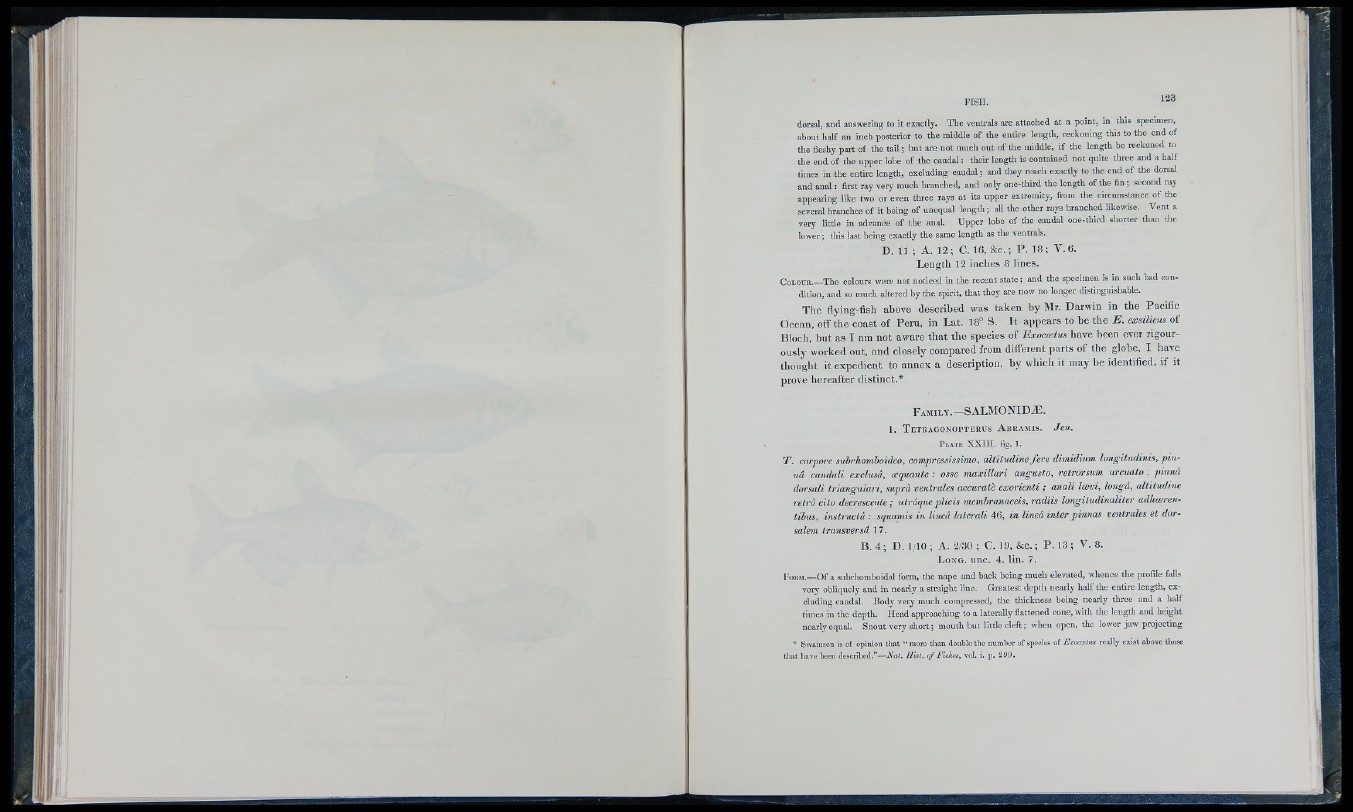
FISH.
dorsal, and answering to it exactly. T he ventrals are attached at a point, in this specimen,
about half an inch posterior to the middle of the entire length, reckoning this to the end of
the fleshy part of tho tall ; but are not much out of the middle, if the length be reckoned to
the end of the upper lobe o f the caudal : their length is contained not quite three and a half
times in the entire length, excluding candal ; and they reach exactly to the end of the dorsal
and anal ; first ray very much branched, and only one-third the length of the fin; second ray
appearing like two or even three rays at its upper extrem ity, from the circumstance of the
several branches of it being of unequal length; all the other rays branched likewise. V ent a
very litfle in advance of the anal. U pper lobe of the caudal one-third shorter than the
lower ; this last being exactly the same length as the ventrals.
D. 11 ; A. 12; C. 16, &c. ; P. 18; V. 6.
L ength 12 inches 8 lines.
C o l o u r .— The colours were not noticed in the recent state ; and the specimen is in such bad condition,
and so much altered by the spirit, that they are now no longer distinguishable.
The flying-fish above described was taken by Mr. Darwin in the Pacific
Ocean, off the coast of Peru, in Lat. 18° S. It appears to be the E . exsiliexis of
Bloch, but as I am not aware that the species of Exoccetus have been ever rigour-
ously worked out, and closely compared from different parts of the globe, I have
thought it expedient to annex a description, by which it may be identified, if it
prove hereafter distinct.*
F a m i l y .— S A LM O N IDÆ .
1. T e t r a g o n o p t e r u s A b r a m is . Jen.
P l a t e X X III. fig. 1.
T . corpore suhrhoniboideo, compressissimo, altitudine fe re dim idium longitudinis, p in nâ
caudali exclusâ, oequante : osse m axillari angusto, retrorsum arcuato : pinnâ
dorsali triangulari, suprà ventrales accurath exoriexiti ; anali la v i, longâ, altitudine
retrd cito decrescente; xitrâquepUcis membranaceis, radiis longitudinaliter adharen-
tibus, iiistructâ : squamis in lineci laterali 4 6, in lineâ inter pinnas ventrales et dorsalem
transversâ 17.
B. 4 ; D . 1/10; A. 2/30 ; C. 19, &c. ; P . 13; V. 8.
L o n g . u n c . 4 . lin . 7.
F o rm .— O f a subrhomboidal form, the nape and back being much elevated, whence the profile falls
very obliquely and in nearly a straight line. Greatest depth nearly half the entire length, excluding
caudal. Body very much compressed, the thickness being nearly three and a half
times in the depth. Head approaching to a laterally flattened cone, with the length and height
nciuly equal. Snout very short ; m outh but little cleft ; when open, the lower jaw projecting
* Swainson is of opinion that “ more than double the number of species of Exocoetus really exist above those
that have been described.”—iVrti. Hist, of Fishes, vol. i. p. 299.